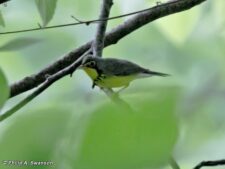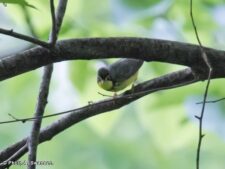
5.5 inches long. The Canada Warbler has a thin pointed bill. There are yellow spectacles on the face. The underparts are yellow and the undertail coverts are white. The upperparts are bluish-gray. There are no wing bars. The adult male has a black necklace and black on the forehead and around the eye. The female and immature birds have a gray necklace and foreheads.
The Canada Warbler is an uncommon late migrant arriving in Mid May through early June. In fall it is seen in Mid August through early October.
The Canada Warbler is often referred to as the “Necklaced Warbler” due to its black spots across the breast. It spends relatively little time on its breeding grounds and is usually one of the last warblers to arrive and one of the first to depart local nesting areas. It often cocks its tail while flicking its wings. This warbler eats insects and spiders. It is an active bird that frequently will fly out to catch bugs which explains its old names of “Canadian Flycatcher” and “Canadian Flycatching Warbler”. Canada Warblers often continue to sing late into the nesting cycle and even during fall migration. The song is a distinctive series of jumbled warbling notes often preceded by a loud chip note.
Disclaimer: The content of NatureSearch is provided by dedicated volunteer Naturalists of Fontenelle Forest who strive to provide the most accurate information available. Contributors of the images retain their copyrights. The point of contact for this page is: Phil Swanson.


